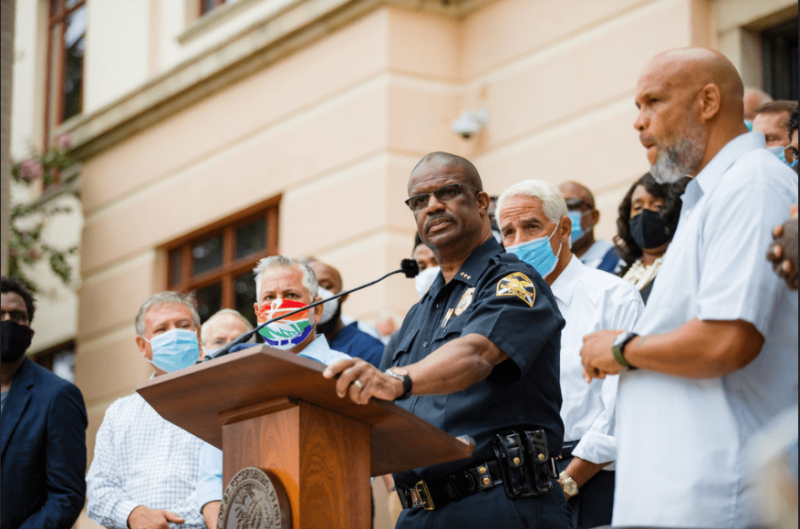St. Pete 2.0: The state of racial equity in St. Pete in 2021 [Survey results part one]

The St. Petersburg renaissance has been in full swing for more than a decade. We’ve excelled in many areas and struggled in others. In our series St. Pete 2.0, we’re partnering with the St. Petersburg Downtown Partnership to explore what lies on the other side of our potential – what will it take to move to the “next level” as a city? Through this series, we’ll dig into specific topics with the hope that you, our thoughtful citizens, will share your insight, experience and wisdom.
St. Petersburg, like many cities across the United States, is still coming to terms with a painful history of systemic racism and injustice. With the deaths of George Floyd and Breonna Taylor shining a spotlight on these issues, the need for change has never been greater, but it will take the collective efforts of everyone in the community to ensure that St. Pete can move toward a more equitable future for all its residents.
In February 2020, we asked Catalyst readers to suggest ways our city could work to overcome systemic racism as part of our St. Pete 2.0 series. Now, after a year when race has been at the forefront of so many of our conversations, we wanted to learn what – if anything – has changed in the community in terms of racial equity. We also wanted to hear your ideas on concrete measures for promoting and supporting diversity, equity and inclusion in St. Pete. Here’s part one of what we found out:
Have your attitudes about race changed in the past year and if so, in what ways?
Even among those who said that their attitudes haven’t changed, this question did prompt deeper reflection by some respondents, most of whom opted to remain anonymous.
“I’m not sure that my attitudes about race have changed, but I have been heartened by white people joining more actively with people of color to stand up against racism,” wrote Kim Cromwell.
Another person shared a similar sentiment regarding the power of speaking out against injustice.
“Black Lives Matter has shown me that continuous direct action can make a difference, and I think it also brought awareness to more people who had the privilege to not pay attention,” the commenter wrote.
On the other side of the coin, several people shared that the events of the past year have opened their eyes to what people of color experience on a daily basis.
“As a white person, I had no idea how rampant police brutality was for the Black community,” wrote Josette Green. “I am absolutely incensed about what happens when one has brown or black skin and am taking advantage of any conversation or training on anti-racism. As a result, I’ve been engaging in more conversation on race and speaking up when I see any type of racial injustice.”
Wrote another:
“I was shocked by George Floyd’s murder. I was also shocked by the riots that followed,” the person wrote. “My liberal church started another ‘racial sensitivity’ program but most participants lost interest after a few weeks.”
Another commenter summed it up even more succinctly.
“I am even more aware of my white privilege.”
Have you seen any specific examples of change in St. Pete over the past year? If so, what are they?
While a number of people responded with a flat-out “no,” those who did cite examples of change generally spoke about the impact of Black Lives Matter demonstrations and their influence on the future of policing in St. Pete.
“The Black Lives Matter demonstrations kept the pressure on the city to respond and make changes to prevent police brutality against Black people,” wrote Amy Walsh. “Sending social workers and not police officers to non-violent calls is one good step, but we still have very far to go to eradicate institutionalized racism.”
Myco Focal agreed.
“The shift in funding away from more police to a more holistic community response team instead is one of the best examples of change and positioned St. Pete as a thought leader to inspire other municipalities to do the same,” he wrote.
However, not everyone agreed with the tactics of the Black Lives Matter demonstrations.
“I was appalled by the BLM disruptions of private diners in struggling businesses during a pandemic,” one respondent wrote. “They were far from ‘mostly peaceful.’ How much BLM money raised out of millions went to local communities of color for job training, tutoring, food banks, job training, etc.?”
Demonstrations and policing aside, one commenter wrote of positive developments in terms of placing an emphasis on supporting minority-owned businesses. Green praised the civil rights exhibit at the Florida Holocaust Museum and the Foundation for a Healthy St. Petersburg’s Courageous Conversations About Race program.
“I don’t see examples of change quite yet as much as I see the seeds planted so that there is change and justice going forward,” she wrote.
Danny White is less encouraged about what he’s seen over the past year.
“I’ve seen no qualitative change in real or perceived racial equity accomplishments,” he said. “Allegedly, African American poverty in St. Petersburg has dropped to its lowest in the past year or so. However, the evidence of such is not glaring nor has the methodology to arrive at such a claim has been widely published, if at all.”
What role do white business leaders have in addressing racial inequity in our community?
Though a few people answered that skin color isn’t relevant and that race should be removed from the question, many felt that white business owners do have a responsibility to help address racial inequity in St. Pete.
“Their role is huge. They have so much power,” wrote Walsh. “They need to hire and train employees in ways that support racial equity, they need to provide goods and services in racially neutral ways and they need to push the city to do more to correct the racial imbalances in areas such as police brutality, economic development and access to health care and social services.”
Several people wrote that white business owners should focus on building a diverse workforce.
“White business leaders must show through their actions their commitment to hire and develop people of color,” Cromwell observed. “Speaking about diversity and inclusion isn’t enough. Training white staff doesn’t bring about the kind of systemic change that’s required. People of color need to be at the table at work and in leading our community and our schools. Business leaders have power to help make that happen.”
In addition to internal policies to promote diversity, commenters said that white business owners should also pay close attention to how they treat their customers and clients.
“They have a role to make their businesses a welcoming place for all individuals and not go out of their way to vocally or visually support systems that are inherently racist to communities,” wrote a respondent named Fay.
Another person said that white business owners and their employees should make “100 percent sure” that they are treating every single person, client or customer – regardless of skin color, ethnicity, age, weight, dialect, sex, handicap, clothing or any other aspect of being human – in an equal and respectful manner.
“Exactly as they would want to be treated, served or provided for,” the commenter shared.
Finally, two respondents shared diametrically opposed viewpoints in terms of what’s most important for white business owners to focus on – equity or equality.
“The first thing business leaders need to recognize is that equity is not equality – simply making a little effort isn’t enough,” one wrote. “Making up for past neglect should be a priority because it serves as the greatest benefit for the entire community.”
Wrote the other:
“We need to focus on racial equality, not equity, which is discriminatory by nature,” the person said. “Equality infers equal opportunity, equity infers quotas. We need to talk about business people as people and not focus on their skin color.”
What do you think prevents the business community in fully engaging?
This question elicited a variety of responses, with many of them touching on the issue of racism.
“Systemic racism, which is so deeply rooted in this country that most of my peers can’t even perceive it,” one commenter wrote. “I don’t know how this can change besides older generations dying off and allowing us younger and more progressive whites to try to begin changing the culture and mindset.”
Basha Jordan concurred.
“It’s racism and a lack of interest in the the needs of minorities in our city of St. Pete,” he said.
Several commenters mentioned that some members of the business community may be afraid of the financial and social repercussions of putting an emphasis on topics of race and equity.
“The bottom line is hidden or buried personal hangups and quite possibly fear of retaliation or rejection by cohorts, colleagues or other clientele,” wrote one person.
White believes that many business owners simply don’t know how to start the conversation.
“There is a fear of engaging in open, honest and respectful dialog about race, racism and caste,” he wrote.
Others felt that business owners may not recognize that they do in fact have a major role to play in building an equitable society.
“I think the white business community frequently does not see the opportunity and the responsibility they have to change the racial (and gender) dynamics in their organizations,” Cromwell said. “Implicit biases lead many white men to hire people like themselves. Finding qualified people from other backgrounds to bring into the fold may require extra effort since our networks often reflect our own backgrounds. We need to treat diversity with the same high expectations and level of measurement and accountability that we deal with other business requirements.”
Another commenter shared a similar thought.
“A lot of businesses are unwilling to put forth the emotional labor being asked of them,” she wrote. “Instead they fall back on blaming the communities themselves rather than their own practices.”
For things to change, Green said, business owners need to be willing to do some soul searching and examine their practices to find ways they can do better.
“Business leaders first and foremost have to look within and each person has to do their own work before they can truly understand how an organization continues on a racist path,” she wrote. “Business leaders: educate yourselves to be anti-racist and question your own beliefs, upbringing and thoughts. Only then can your business do the same. If the leader doesn’t get it, the organization never will either.”







